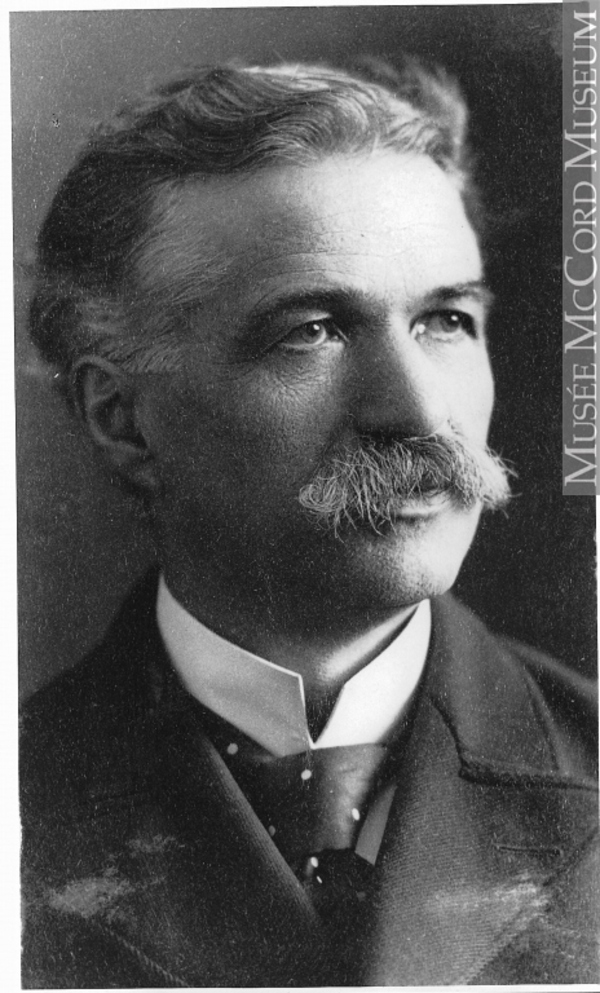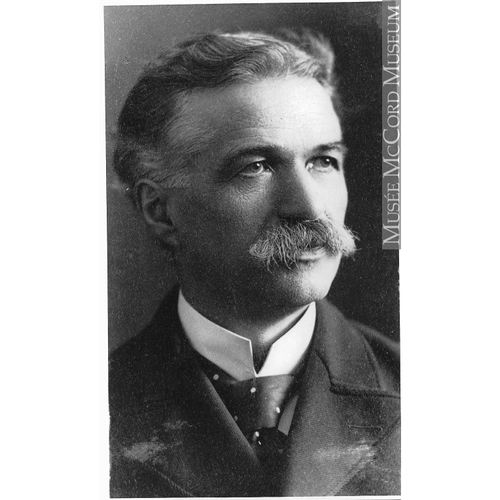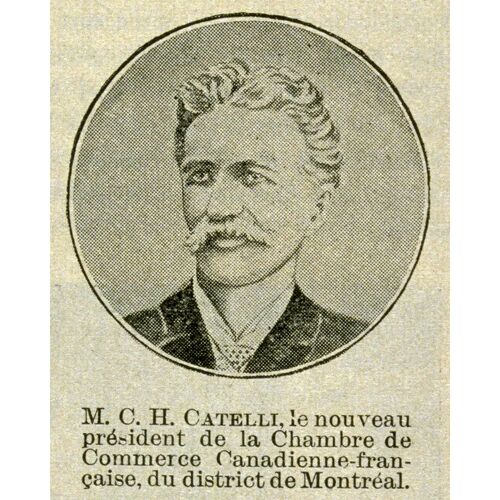
Source: Link
CATELLI, CARLO ONORATO (Charles-Honoré), businessman and community leader; b. 1849 in Vedano Olona, Italy, son of Martino Catelli and Maria Pessina; m. 15 Sept. 1879 Angelina Armand (d. 1897) in Rivière-des-Prairies (Montreal), and they had nine children, of whom two survived to adulthood; d. 13 Oct. 1937 in Montreal.
Family background and immigration
Carlo Onorato Catelli immigrated to Quebec from Italy’s Lombardy region around 1866 and settled in Montreal. His hometown, Vedano Olona, had a population of about 1,800 in the late 1860s. According to a contemporary almanac, one of the town’s two municipal councillors was Martino Catelli, a name unusual enough to suggest that this was Carlo Onorato’s father. A significant number of people from this northern region of the country came to Canada before the large-scale Italian emigration in the late 19th and early 20th centuries. Carlo Onorato and his older brother Pietro (Pierre, Peter) immigrated to Montreal around the same time. They were likely assisted by their paternal uncle Carlo (Charles) Catelli, who had arrived in the city in 1845, when he was in his late twenties. Roman Catholic and French-speaking, all three would adopt French versions of their given names not long after their arrival but would continue to use their Italian ones as well. Carlo Onorato tended to use French given names in his professional life and Italian ones in his personal life. Uncle Carlo was very close to his two nephews, and up until the mid 1880s the three men would live either together on Rue Craig (Rue Saint-Antoine) or very near to one other. Carlo Onorato and his uncle remained neighbours until the mid 1890s. Their close relationship is evidenced by Carlo Onorato’s marriage record, on which his uncle is listed as his adoptive father.
The pasta business
The official history of the company that would become known as Catelli, one of the most famous Italian brands in Canada, affirms that Carlo Onorato began to produce pasta by hand on Rue Saint-Paul in Montreal in 1867. His entry in the 1923 edition of Biographies canadiennes-françaises, for which Carlo Onorato most likely provided the information, lists the same date. The early years of the business are poorly documented, however, and no primary sources have been found that prove he started the enterprise on that date. Furthermore, neither he nor his business appears in city directories before 1872–73. In that first entry he (“Chs., jun.”), his brother, and his uncle are listed under “Catelli & Frère, cooks and Vermicielli manufacturer,” at the same address as Carlo’s statuary-making business on 68 Rue Notre-Dame. The senior Catelli is no longer listed with the pasta business the following year. While his nephews were engaged in that enterprise, he would continue his career as a sculptor and manufacturer of plaster statuary, often working with the Carli family [see Alexandre Carli]. In the late 1890s he would serve as a justice of the peace.
Curiously, in 1869–70, three years before Carlo Onorato appears in city directories, a baker listed as “Pierre Catello” occupied 59 Rue Perthius, near Square Viger. At that address the following year is “Pietro Catelli, manufacturer of macaroni and vermicelli, and Italian paste.” From 1872–73 the siblings appear together as “Catelli & Frère” at the Notre-Dame address or at Berri Lane (Rue Berri), and from 1876–77 as “Catelli Brothers, manufacturers of macaroni, vermicelli and alimentary food” at 53 to 59 Rue Perthius. In 1880–81 the business appears at the same address as “C. H. Catelli, successor to Catelli Bros.,” which suggests that Pietro had left the enterprise around that time. Pietro is subsequently entered as a trader, a cardboard and playing-card manufacturer, and a real-estate agent, among other occupations, and in 1894–95 he is associated with an “Italian immigration office.” Around 1896 he relocated to the United States, where he often used the English version of his first name, Peter. Historians Bruno Ramirez and Michael Del Balso state that he fled Montreal because of his involvement with fraudulent banking practices, and the Gazette officielle de Québec shows that he was embroiled in a land dispute in 1895. In the United States federal censuses of 1920 and 1930 respectively, he is recorded as living in Clinton, N.Y., with his second wife and children, and then in New York City, where he died in 1937.
While the extent of Pietro’s role in the launch of the enterprise and the reasons for his departure remain a mystery, it was clearly Carlo Onorato who transformed the small family operation into a large company. At first the business catered mostly to Montreal’s Italian population, which was about 1,400 in 1893, but it gradually increased its non-Italian client base. The affordability of its products no doubt contributed to its success; according to Le Prix courant (Montreal), in 1891 one pound of Catelli macaroni cost about five cents, less than half the price of the imported equivalent. That year the Bradstreet credit agency valued the net worth of the business between $2,000 and $3,000.
In 1908 Charles-Honoré and general manager Tancrède Bienvenu incorporated as the C. H. Catelli Company Limited. Around that time they established a factory on the corner of Rue Drolet and Rue de Bellechasse in Montreal’s Little Italy. In 1910 Bradstreet estimated the company’s net worth between $75,000 and $100,000. A newspaper advertisement the following year boasted that its “Hirondelle” brand of pasta had “gained the favour of Canadian housewives.” In an article about a large fire at their factory in Little Italy, Le Devoir (4 March 1913) stated that before the incident the facility had 50 employees and could produce 50,000 pounds of macaroni and vermicelli per week. Annual revenue was reported to be $200,000, and in 1914, after the factory was rebuilt, C. H. Catelli was said to be the oldest and largest pasta company in the country, with the most modern equipment. An overview of the enterprise published in the newspaper in 1925 would state that in 1914 Charles-Honoré retired from the pasta business a wealthy man. In 1918 Bienvenu and four of his sons took control of the company, which by 1925 reportedly employed about 150 people and produced between 10 and 11 million pounds of pasta per year.
Other business activities
Catelli remained active in public and private affairs both before and after his retirement from the pasta business. In 1892 he had been a founding member of the Alliance Nationale [see Sir Hormisdas Laporte], a French Canadian mutual-aid society. He sat on the board of directors of the Montreal Industrial Exhibition Association in 1909, and three years later was a director of both the Montreal Terminal Railway and the Chateauguay and Northern Railway companies. From about 1913 he served as vice-president of Champs d’Or Rigaud-Vaudreuil, a gold-mining firm. He remained in that position for more than 20 years, and in 1932 he also became president of the Montreal Dairy Company.
Marriage and children
In 1879 Carlo Onorato had married Angelina Armand, the daughter of Canadian senator Joseph-Flavien Armand. Between 1880 and 1895 the couple had nine children, but only two lived to adulthood. The elder of the two was baptized in 1891 as Joseph-Charles-Honoré-Léon (known as Léon), no doubt in honour of his father and his godfather, Joseph-Charles Beauchamp. His sister Marguerite (Margherita) was born in 1895, two years before her mother’s death. In 1917 Marguerite married Leopoldo Zunini, who served as the Italian consul in Montreal from about 1916 to 1919. Zunini would be transferred to Chicago as Italian consul, but not before Marguerite gave birth to their first child, a daughter, baptized in 1918. Carlo Onorato was recorded as the newborn’s godfather.
A prominent Italian in Montreal
Before his withdrawal from pasta manufacturing, Carlo Onorato had become what Canadian men and women of the time (1912) described as “the most prominent member of the Italian colony in [Montreal].” His rise in stature began with his marriage to a senator’s daughter. Three years before his naturalization in 1889, he was among the French-speaking entrepreneurs who founded the Chambre de commerce du district de Montréal. From 1906 to 1908 he served as its president, a position that coincided with his roles as the honourable commissioner to the universal exposition in Milan, Italy, in 1906, and as a delegate to the sixth Congress of Chambers of Commerce of the Empire, held that year in London.
In 1900 Catelli had lobbied for the establishment of a Catholic church for Montreal’s Italian population, and five years later the parish of Notre-Dame-du-Mont-Carmel was created, stretching from the St Lawrence River in the south to Avenue du Mont-Royal in the north, and from Rue de la Montagne in the west to Avenue de Lorimier in the east. Catelli would live within the parish for the rest of his life. A second parish for the city’s Italians, Notre-Dame-Della-Difesa (Notre-Dame-de-la-Défense), was established in Little Italy in 1910. Catelli was among a group that sought funding for an Italian school, set up in 1908 at the same address as the parish church of Notre-Dame-du-Mont-Carmel, 479 Rue Dorchester Est (Boulevard René-Lévesque Est).
In 1902 Catelli had been among the founders of the newly incorporated Italian Immigration Aid Society for Canada (IIASC) in Montreal and was elected president. A charitable organization funded by the Italian government, its main goals were to help Italians immigrate to Canada and find work, limit their transience, defend their contracts, and address the abusive practices of some private labour agents. The society’s vice-president, Alberto Dini, had been a private immigration agent since at least 1898. Dini’s chief rival was Antonio Cordasco*, the city’s most powerful private Italian immigration agent, or padrone, who had an exclusive arrangement to supply the Canadian Pacific Railway Company with workers. In the spring of 1904, advertisements by Cordasco and other padroni resulted in the arrival of thousands of would-be Italian labourers for whom there was no work. The IIASC alerted the mayor of Montreal, Hormisdas Laporte, who in turn informed Prime Minister Sir Wilfrid Laurier*. The result was the creation of the royal commission appointed to inquire into the immigration of Italian labourers to Montreal and the alleged fraudulent practices of employment agencies. Among the commissioners was a founder of the IIASC, Jerome Internoscia. Testifying to the commission, Catelli presented his knowledge of the situation, described the efforts he had made to improve the conditions of those who were unemployed and destitute, and recommended that private labour agencies be prohibited. When Dini was asked about an advertisement in his name that called for 10,000 labourers for Canada for the 1904 work season, he denied responsibility. The commission took no action against him; its focus was Cordasco, who was blamed along with the Canadian Pacific Railway Company. As a result, Cordasco was removed from his position. When in January 1905 Dini was elected to replace Catelli as president of the IIASC, Montreal’s Italian consul, Francesco Mazza, used his power to disregard the results and reinstate Catelli.
For his leadership among Italians in Montreal, Catelli had been recognized in 1904 by the Italian king, Victor Emmanuel III, who bestowed the title of cavaliere, or chevalier, of the Order of the Crown of Italy. This honour was elevated when he was received by the Italian king and made a commendatore (commander) around 1906. That year he was granted an audience with Pope Pius X. A life member of the prestigious Canadian Club of Montreal, Catelli was on close terms with some of the most prominent members of Canadian society of his day.
Later years
In the early 1920s Catelli participated in an initiative headed by Father Romualdo M. Migliorini to set up an orphanage for Italian children, which resulted in the establishment of the Orphelinat Saint-Joseph in 1922. Catelli was named the first president of the association in charge of its administration.
Towards the end of his life Catelli participated in a cause championed by Italian consular officials in Montreal. In the early 1930s, as part of a campaign to extend the reach of Benito Mussolini’s Fascist government in Italy, his diplomats in Montreal (and elsewhere in Canada) began to establish sites where Italian immigrants could gather to socialize, attend political meetings, and send their children for Italian-language instruction. Catelli extended his support to that successful campaign, which resulted in the opening of Montreal’s Casa d’Italia in 1936.
The following year Catelli died at his home. Celebrated for his entrepreneurial success and his contributions to Montreal’s Italian community, he was buried in Notre-Dame-des-Neiges cemetery. The business that bears his name has persisted for more than 150 years as one of Canada’s most successful pasta companies.
Ancestry.com, “1920 United States federal census,” Peter Catelli: www.ancestry.ca/search/collections/6061 (consulted 7 Feb. 2023); “1930 United States federal census,” Peter Catelli: www.ancestry.ca/search/collections/6224 (consulted 7 Feb. 2023); “Quebec, Canada, vital and church records (Drouin coll.), 1621–1968,” Saint-Joseph (Rivière-des-Prairies [Montréal]), 15 sept. 1879; Notre Dame (Montréal), 18 oct. 1891, 16 oct. 1937; Saint-Louis de France (Montréal), 22 juill. 1895: www.ancestry.ca/search/collections/1091 (consulted 26 Oct. 2023). LAC, R233-35-2, Que., dist. Montreal City (90), subdist. East Ward (D): 117; R233-36-4, Que., dist. Montréal Centre (172), subdist. St Jacques Ward (4): 16; R233-37-6, Que., dist. Montreal City, subdist. St Louis Ward (B32): 2; R233-177-0, Que., dist. Montreal St Antoine (180), subdist. St Antoine Ward (35): 30. Éric Bédard, “Les Catelli: Charles-Honoré, entrepreneur et notable,” Journal de Montréal, 17 déc. 2011. Le Devoir, 24 août 1911, 4 mars 1913, 7 mars 1914, 7 mars 1925, 12 juin 1926. Gazette (Montreal), 13 Dec. 1909. London Gazette, 9 Aug. 1907: 5448. Montreal Daily Star, 15 Feb. 1905. Le Prix courant (Montréal), 11 sept. 1891. Spectator (London), 14 July 1906: 3. Acte d’incorporation, constitution, règlements, liste des membres et catalogue de la bibliothèque du Club canadien de Montréal (Montréal, 1916). Kenneth Bagnell, Canadese: a portrait of the Italian Canadians (Toronto, 1989). Bradstreet’s book of commercial ratings of bankers, merchants, manufacturers, etc., in the United States and Canada (New York), 1910. Bradstreet’s commercial reports … (New York), 1891. Can., Royal commission to inquire into the immigration of Italian labourers to Montreal and the alleged fraudulent practices of employment agencies, Report of commissioner and evidence (Ottawa, 1905). Canada Gazette, 1908: 2016. Directory, Montreal, 1850–1938. Y. C. L. Gadler, “The education of Italians in Montreal, 1895 to 1960” (ma thesis, McGill Univ., Montreal, 1994). Gazette officielle de Québec, 1895: 1604. Genealogy of Can., “Genealogy Charles-Honore Catelli”: www.nosorigines.qc.ca/GenealogieQuebec.aspx?genealogy=Charles-Honore_Catelli&pid=818422&lng=en (consulted 7 Feb. 2023). R. F. Harney, “Montreal’s king of Italian labour: a case study of padronism,” Labour (Halifax), 4 (1979): 57–84. Jacinthe Laplante, “Fascisme et communauté italienne de Montréal d’après L’Italie Nuova (1937–1939)” (ma thesis, Univ. de Sherbrooke, Sherbrooke, Québec, 2008). P.-A. Linteau et al., Histoire du Québec contemporain (2v., Montréal, 1979–86), 1 (De la Confédération à la crise, 1867–1929). Manuale della provincia di Como pel 1869 [Manual of the province of Como for 1869] (Como, Italy, [1869?]; copy at archive.org/details/almanaccostatist1869cava). Giosafat (Jos) Mingarelli, Gli Italiani di Montreal: note e profili [The Italians of Montreal: notes and profiles] (Montreal, 1957). Gunther Peck, Reinventing free labor: padrones and immigrant workers in the North American west, 1880–1930 (Cambridge, Eng., 2000). Que., Dept. of Colonization, Mines and Fisheries, Mines Branch, Report on mining operations in the province of Quebec during the year 1911, 1912. Bruno Ramirez and Michael Del Balso, The Italians of Montreal: from sojourning to settlement, 1900–1921 (Montreal, 1980). A. V. Spada, The Italians in Canada/Les Italiens du Canada (Ottawa, 1969). Statue of Liberty – Ellis Island Foundation: www.statueofliberty.org (consulted 7 Feb. 2023). Sylvie Tremblay, “Les Catelli,” Cap-aux-Diamants (Québec), no.82 (été 2005): 48. P. G. Vangelisti, Gli Italiani in Canada [The Italians in Canada] (Montreal, 1956).
Cite This Article
In collaboration with Gabriele Scardellato, “CATELLI, CARLO ONORATO (Charles-Honoré),” in Dictionary of Canadian Biography, vol. 16, University of Toronto/Université Laval, 2003–, accessed April 27, 2025, https://www.biographi.ca/en/bio/catelli_carlo_onorato_16E.html.
The citation above shows the format for footnotes and endnotes according to the Chicago manual of style (16th edition). Information to be used in other citation formats:
| Permalink: | https://www.biographi.ca/en/bio/catelli_carlo_onorato_16E.html |
| Author of Article: | In collaboration with Gabriele Scardellato |
| Title of Article: | CATELLI, CARLO ONORATO (Charles-Honoré) |
| Publication Name: | Dictionary of Canadian Biography, vol. 16 |
| Publisher: | University of Toronto/Université Laval |
| Year of revision: | 2024 |
| Access Date: | April 27, 2025 |




